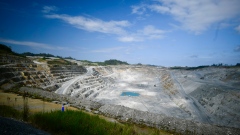Apr 30, 2024
Mexico’s Economy Posts Slight Growth Ahead of Key Rate Meeting
, Bloomberg News

(Bloomberg) -- Mexico’s economy posted small growth in the first quarter compared to the previous three-month period, as policymakers consider whether to deliver an additional interest rate cut at next week’s meeting.
Gross domestic product expanded 0.2% in the January-March period on a quarterly basis, slightly above the 0.1% median estimate of economists surveyed by Bloomberg. From a year earlier, GDP grew 1.6% in the quarter, below the 2.3% median forecast, according to preliminary data published Tuesday by Mexico’s national statistics institute.
“When we have high inflation, even with this growth, Mexico is at risk of falling into stagflation,” said Gabriela Siller, director of economic analysis at Banco Base. “The weakness of the secondary sector could be related to the loss of competitiveness in exports because of the strength of the peso.”
Read More: Mexican Peso Volatility Isn’t Risk to Prices, Banxico Chief Says
The services sector expanded 0.7%, industrial production fell 0.4%, and agricultural output declined 1.1% on a quarterly basis. Despite the weak growth, the numbers could give Mexico’s central bank reason to keep interest rates unchanged.
“Banxico board members should feel more comfortable with a pause in May with the strength of the services sector,” said Gabriel Casillas, chief Latin America economist at Barclays Plc. “A strong services sector should provide them with more confidence that cutting at a slow pace and in no consecutive way is the right thing to do.”
After cutting interest rates for the first time since 2021 in March to 11% from 11.25%, the central bank has said future adjustments will be gradual and evaluated one at a time. However, Deputy Governor Jonathan Heath said Banxico, as the central bank is known, may vote unanimously to hold borrowing costs at its next meeting on May 9.
Losing Steam
Latin America’s second-biggest economy beat economists’ expectations for much of 2023 before headwinds, including tight financial conditions imposed by the central bank and the effect of the strong peso on remittances, finally slowed it down. It grew just 0.1% in the October-December period compared to the previous quarter, as manufacturing and construction activity contracted.
What Bloomberg Economics Says
“First-quarter GDP data show Mexican activity has lost momentum after strong growth over most of the past two years. The figures signal weaker investment amid tight financial conditions, lower public-sector outlays and uncertainty ahead of the Mexico and US elections this year. Consumption has held up given low unemployment, higher real wages and increasing government transfers.”
— Felipe Hernandez, Latin America economist
Click here to read the full report.
Read More: Mexico Economy Stalls, Bolstering March Rate Cut Forecasts
Last year’s domestic growth of 3.2% was driven in part by government spending on social programs and flagship construction projects like the Maya Train and Pemex’s Dos Bocas refinery. Company investments in operations to serve customers in Mexico’s northern neighbor, a process known as nearshoring, also provided a boost. President Andres Manuel Lopez Obrador has further increased spending ahead of the June presidential election, which could accelerate economic growth later this year.
The median estimate in the most recent Citibanamex survey of analysts is for the central bank to resume easing in June.
--With assistance from Rafael Gayol.
(Update with analyst comments starting in fourth paragraph, sector data in fifth.)
©2024 Bloomberg L.P.








